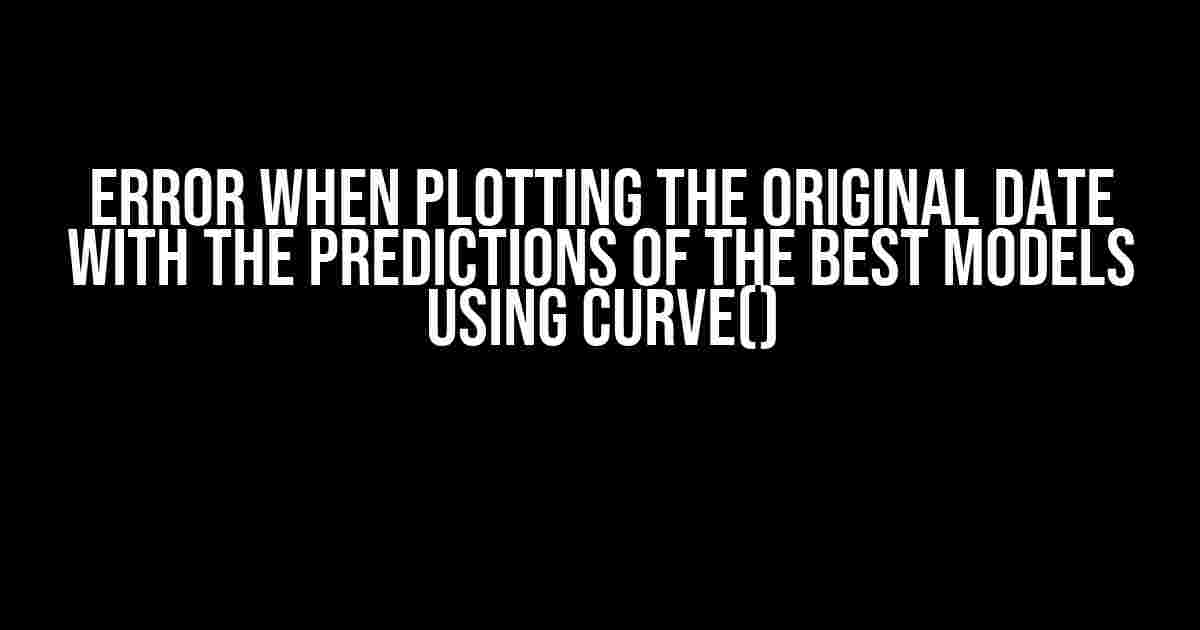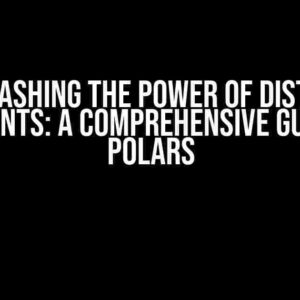If you’re a data enthusiast, you’ve probably encountered the frustrating error when trying to plot the original date with the predictions of the best models using the curve() function. This error can be a major roadblock in your data analysis journey, but fear not! In this article, we’ll delve into the reasons behind this error and provide you with step-by-step instructions to overcome it.
What is the curve() function?
The curve() function is a powerful tool in the R programming language that allows you to create a curve representing the relationship between a dependent variable and one or more independent variables. It’s commonly used in regression analysis to visualize the predicted values of a model.
The Error: What’s Going On?
When you try to plot the original date with the predictions of the best models using the curve() function, you might encounter an error message like this:
Error in curve(expr, from = from, to = to, ...) :
'expr' must be a function
This error occurs because the curve() function requires a function as its first argument, but you’re providing a vector of values instead. The curve() function is designed to plot a curve based on a function, not a set of data points.
Solution 1: Use the predict() function
A simple solution to this error is to use the predict() function instead of the curve() function. The predict() function allows you to generate predicted values for a model based on a set of new data.
Here’s an example:
R> # Load the lm model
R> model <- lm(y ~ x, data = dataset)
R> # Create a sequence of new x values
R> new_x <- seq(min(dataset$x), max(dataset$x), by = 0.1)
R> # Generate predicted values
R> predicted_y <- predict(model, newdata = data.frame(x = new_x))
R> # Plot the original data
R> plot(dataset$x, dataset$y)
R> # Add the predicted values to the plot
R> lines(new_x, predicted_y)
In this example, we use the predict() function to generate predicted values for the model based on a sequence of new x values. We then add these predicted values to the original plot using the lines() function.
Solution 2: Use the forecast() function
If you’re working with time series data, you can use the forecast() function from the forecast package to generate predicted values for a model.
Here’s an example:
R> # Load the necessary packages
R> library(forecast)
R> # Create a time series object
R> ts_data <- ts(dataset, start = c(2010, 1), end = c(2015, 12), frequency = 12)
R> # Fit an ARIMA model
R> model <- auto.arima(ts_data)
R> # Generate forecasted values
R> forecasted_y <- forecast(model, h = 24)
R> # Plot the original data
R> plot(ts_data)
R> # Add the forecasted values to the plot
R> lines(forecasted_y)
In this example, we use the forecast() function to generate forecasted values for the ARIMA model. We then add these forecasted values to the original plot using the lines() function.
Solution 3: Use the ggplot2 package
Another solution is to use the ggplot2 package, which provides a more flexible and customizable way of creating plots.
R> # Load the necessary packages
R> library(ggplot2)
R> # Create a data frame with the original data and predicted values
R> df <- data.frame(x = dataset$x, y = dataset$y, predicted_y = predicted_y)
R> # Create a ggplot object
R> ggplot(df, aes(x = x, y = y)) +
geom_point() +
geom_line(aes(y = predicted_y, color = "Predicted"))
In this example, we create a data frame with the original data and predicted values, and then use the ggplot2 package to create a plot with the original data points and the predicted values.
Common Pitfalls and Troubleshooting
When using the curve() function, it’s essential to ensure that you’re providing a function as the first argument. If you’re encountering errors, double-check that you’re using the correct syntax and that your function is correctly defined.
Additionally, make sure that your data is in the correct format. The curve() function requires a numerical vector of x values, so ensure that your data is numeric and not a date or character vector.
Conclusion
In conclusion, the error when plotting the original date with the predictions of the best models using the curve() function can be resolved by using alternative methods such as the predict() function, the forecast() function, or the ggplot2 package. By understanding the underlying causes of the error and using the correct syntax and functions, you can create informative and accurate plots to visualize your data.
Additional Resources
If you’re new to R or data analysis, here are some additional resources to help you improve your skills:
- RDocumentation: The official R documentation provides extensive resources and tutorials on using R for data analysis.
- DataCamp: DataCamp offers interactive courses and tutorials on R, data science, and machine learning.
- Kaggle: Kaggle is a platform that provides datasets, competitions, and tutorials on data science and machine learning.
Frequently Asked Questions
Here are some frequently asked questions related to the error when plotting the original date with the predictions of the best models using the curve() function:
| Question | Answer |
|---|---|
| What is the curve() function used for? | The curve() function is used to create a curve representing the relationship between a dependent variable and one or more independent variables. |
| Why does the curve() function require a function as its first argument? | The curve() function requires a function as its first argument because it needs to evaluate the function at a range of x values to generate the curve. |
| How can I plot the original data with the predicted values using the curve() function? | You can’t directly plot the original data with the predicted values using the curve() function. Instead, use the predict() function or the forecast() function to generate predicted values, and then add them to the original plot using the lines() function or the ggplot2 package. |
We hope this article has provided you with a comprehensive understanding of the error when plotting the original date with the predictions of the best models using the curve() function, as well as practical solutions to overcome it. Happy plotting!
Frequently Asked Question
Get answers to the most common questions about error when plotting the original date with the predictions of the best models using curve().
What is the most common error encountered when plotting the original date with the predictions of the best models using curve()?
The most common error encountered is the mismatch between the original date and the predicted values. This often occurs when the date values are not properly formatted or the curve function is not correctly configured, leading to incorrect plotting of the data.
How can I fix the issue of different date formats between the original data and the predicted values?
To fix this issue, ensure that both the original date and predicted values are in the same format. You can use the pd.to_datetime() function to convert the date columns to a uniform format. Additionally, verify that the curve function is correctly configured to handle the date format.
What is the importance of properly formatting the date values when using curve() to plot the original data with predictions?
Properly formatting the date values is crucial when using curve() to plot the original data with predictions. This ensures that the dates are accurately represented on the x-axis, providing a clear visualization of the data. If the dates are not correctly formatted, the plot may not accurately reflect the relationships between the data, leading to incorrect interpretations.
How can I troubleshoot the error when plotting the original date with the predictions of the best models using curve()?
To troubleshoot the error, start by verifying the data types of the original date and predicted values. Then, check the configuration of the curve function to ensure it is correctly handling the date format. If the issue persists, try converting the date columns to a uniform format using pd.to_datetime() and re-running the curve function.
What are some best practices for plotting the original date with the predictions of the best models using curve()?
Some best practices include ensuring the original date and predicted values are in the same format, using a consistent date format throughout the plot, and verifying the curve function is correctly configured to handle the date format. Additionally, consider using a date-based x-axis label and including a legend to differentiate between the original data and predicted values.



